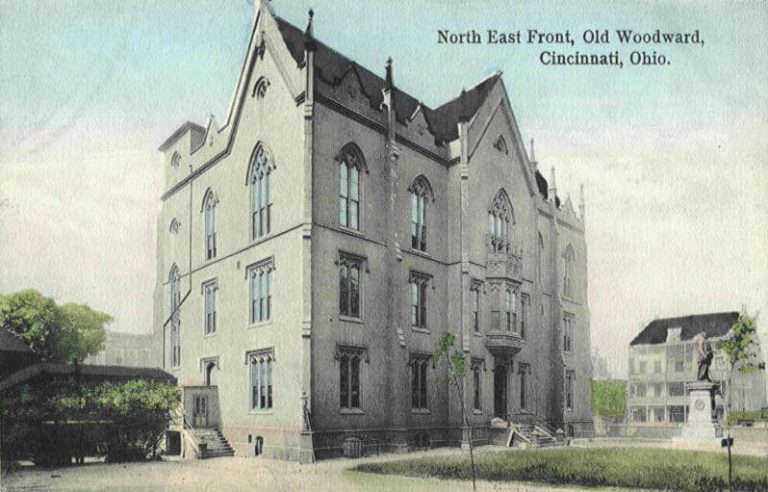Fostering Innovation in Education
We value remaining open and accessible to new organizations and new ideas. Our annual grant requests unlock opportunities to empower Cincinnati's educational future.
Our Origin
The original Woodward Trust was established by leather tanner William Woodward and his wife Abigail Cutter Woodward in 1827. It was intended to benefit underprivileged school children residing in the City of Cincinnati.
William Woodward’s vision was to offer a primary education to all children of Cincinnati regardless of the financial means available to a child’s family. His vision of education pre-dated the Ohio public school system and, to further his goals, he established Woodward Free Grammar School and, later, Woodward High School and Woodward College (now part of the University of Cincinnati), each originally located on the same site at Sycamore and 13th Streets.
In 1831, the Woodwards, took a significant step towards reshaping the educational landscape of Cincinnati. Their generous donation of a parcel of land, comprising roughly a block and a half immediately south of Sycamore and 13th Streets, marked the establishment of the 5-member “Board of Trustees of the Woodward High School of the city of Cincinnati.” Their endowment aimed to ensure that children, whose parents faced financial constraints, could access Woodward High School. While the donated land could be leased for 15-year terms, a crucial stipulation was that it could not be sold or otherwise disposed of, ensuring its enduring educational purpose.
Woodward High School soon became an part of “The Common Schools of Cincinnati” (now known as the Cincinnati Public Schools), supported by property taxes to enable all children to attend free of charge. However, the Woodward Trust’s mission remained unwaveringly focused on providing educational benefits to needy children in Cincinnati. Throughout the years, numerous deeds and documents have guided the evolution and structure of the original Woodward Trust, with a rich history detailing significant events and key documents that have shaped its ongoing commitment to educational support for the community.
The Woodward Trust of Today
Mr. Woodward’s enduring vision for education continues to shape the present through the dedicated efforts of the Woodward Trust and Cincinnati Public School’s Woodward High School. At the heart of this commitment lies the Trust’s mission to uplift underprivileged children in Cincinnati by providing vital support. This support takes various forms, ranging from the procurement of essential school supplies to facilitating enriching educational field trips and offering scholarships. Moreover, the Trust indirectly bolsters extracurricular programs, thereby enhancing the overall educational experience for students.
As the legacy has evolved over time, a series of deeds and documents have played a pivotal role in guiding and refining the Woodward Trust’s actions and organizational structure. Today, the “Woodward Trust” represents the amalgamation of several independent trust funds, all overseen by the same dedicated board of trustees. This collaborative approach enables the Trust to maximize its impact, ensuring that Mr. Woodward’s vision of providing quality education to all children of Cincinnati remains vibrant and relevant in the present day.
Additional Funds
In addition to the “original” Woodward Trust, numerous individuals and organizations have contributed additional money and other assets for the benefit of the same needy Cincinnati students. These funds have either been accepted directly into the original Woodward Trust (where legally permitted to do so), or have been administered separately but simultaneously by the Woodward Trustees.
Rebecca Friday Fund
In 1940, the Last Will and Testament of Rebecca Friday (believed to have been a CPS teacher) bequeathed an $80,000 endowment whose income was to be given for the benefit of the pupils of Bloom, Oyler, Rothenberg, Stowe and Woodward Junior High Schools who are children of needy families. These five schools, at the time, were the only junior high schools in the Cincinnati Public School system. As per her wishes, the funds have been available to all CPS junior high schools or, where schools have been combined, to needy 7th and 8th graders.
The Louise E. Bettens Fund
In 1919, Edward D. Bettens (1848-1921?), a graduate of Woodward High School, established a memorial to his mother, Louise E. Bettens (1827-1914). The memorial initially consisted of a variety of Mrs. Bettens’ books, bookcases, pictures, prints and bronzes, plus $3,000, the income from which was to be used to maintain the items given and, thereafter, to aid worthy pupils needing financial assistance to complete their course at Woodward High School.
Subsequently, the Last Will and Testament of Edward Bettens bequeathed all his property to the Louise E. Bettens Fund. Upon his death and clearing probate in 1921, an additional $50,496 was added to this fund. Edward Bettens, also a graduate of Harvard College, also created a sizeable Louise E. Bettens Memorial Fund at that institution.
The William Gamble Nast Memorial Scholarship Fund
Many felt that the 1921 memorial service for M. Louise Armstrong ( ?? – 1921), while very beautiful, was too transitory to adequately express the sentiment of the community for the great work done by Miss Armstrong as a teacher for many years at Woodward High School. As a result, a committee was formed to arrange for a permanent memorial. The result of this effort was a principal amount of $6,668 given to the Woodward Trustees in 1922. The income from these funds was to be used to assist worthy pupils in Woodward High School and to provide an annual scholarship to the Cincinnati Kindergarten Training School (Linton St., Cincinnati, OH).
The William Gamble Nast Memorial Scholarship Fund
Many felt that the 1921 memorial service for M. Louise Armstrong ( ?? – 1921), while very beautiful, was too transitory to adequately express the sentiment of the community for the great work done by Miss Armstrong as a teacher for many years at Woodward High School. As a result, a committee was formed to arrange for a permanent memorial. The result of this effort was a principal amount of $6,668 given to the Woodward Trustees in 1922. The income from these funds was to be used to assist worthy pupils in Woodward High School and to provide an annual scholarship to the Cincinnati Kindergarten Training School (Linton St., Cincinnati, OH).
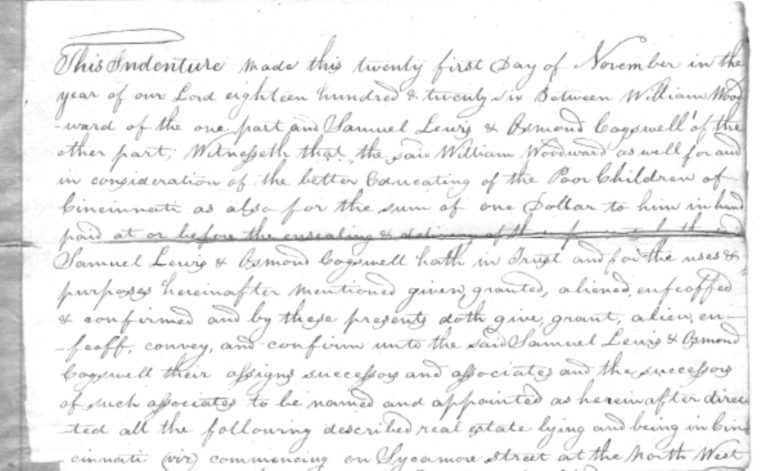
On 11/21/1826, William & Abigail Woodward gave seven acres of land below Woodward (13th) Street to Samuel Lewis & Osmond Cogswell, as two of three trustees, to establish and maintain a free grammar school for the benefit of the poor children of Cincinnati. At that time, there were no free public schools in Cincinnati.
On 1/24/1827, the Ohio General Assembly incorporated the trustees of The Woodward Free Grammar School, as established by the “1826 Woodward Trust Deed” as well as further requirements and restrictions not provided for in Woodward’s original deed – including details relative to use, administration and appointments, and the non-sale and perpetual leasing of the land. [The incorporation changed in material respects the terms of the trust as set forth in the deed.]
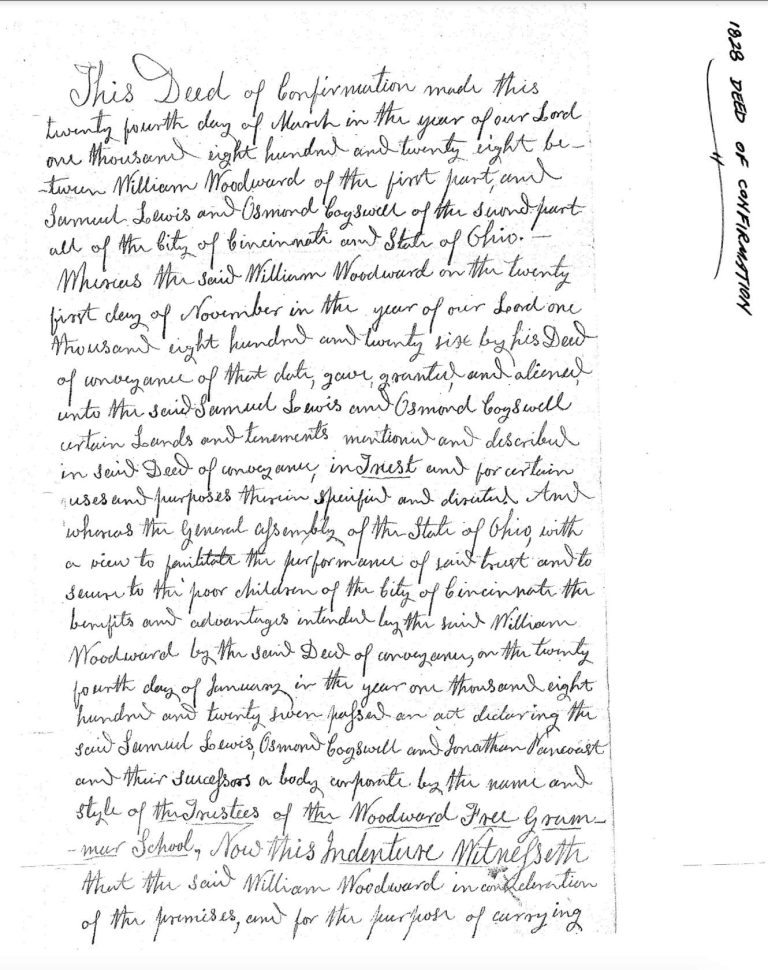
On 11/21/1826, William & Abigail Woodward gave seven acres of land below Woodward (13th) Street to Samuel Lewis & Osmond Cogswell, as two of three trustees, to establish and maintain a free grammar school for the benefit of the poor children of Cincinnati. At that time, there were no free public schools in Cincinnati.
In 1828, the City of Cincinnati opened its first free public primary school.
On 5/25/1830, in light of the availability of free public primary school education, William Woodward extended the use and application of The Woodward Free Grammar School assets to establish and maintain a free high school for the benefit of the poor children of Cincinnati.
On 12/16/1830, William & Abigail Woodward gave land above Woodward (13th) Street to Samuel Lewis & Osmond Cogswell, as two of five trustees, to establish and maintain a free high school. [This document has no relation to what is today the Woodward Trust.]
On 1/15/1831, the Ohio General Assembly repealed its “1827 Woodward Act” and incorporated the trustees of The Woodward High School, as established by the “1830 Trust Indenture,” again including further requirements and restrictions not provided for in Woodward’s deeds and indenture – including details relative to use, administration and appointments, and the non-sale and perpetual leasing of the land. [The incorporation again changed in material respects the terms of the trust as set forth in the deeds and indenture.]
Particularly illuminating as to the continuing intent of William Woodward: Upon becoming aware that those who would have qualified for his originally-intended beneficence were now otherwise provided for, he immediately extended his generosity to a new class of poor youth.
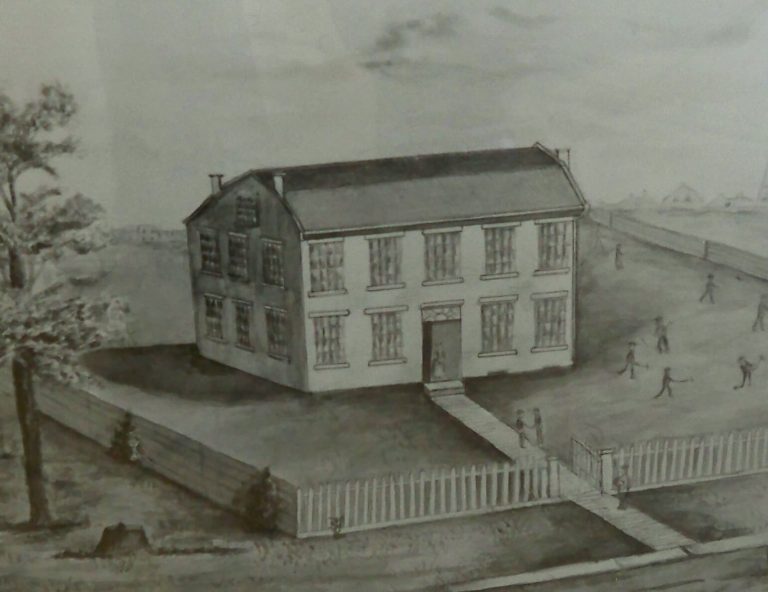
The first Woodward High School opened on October 24, 1831.
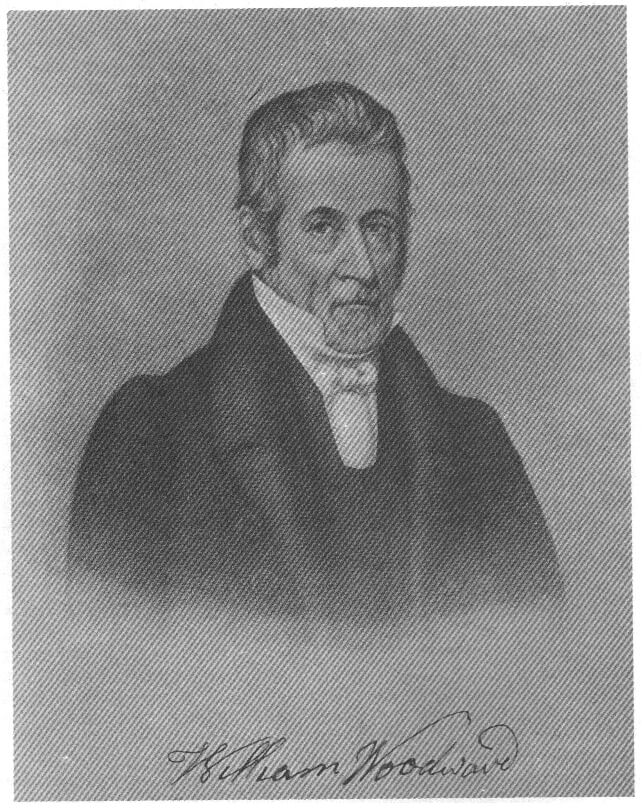
William Woodward died on January 24, 1833.
An 1836 act of the Ohio Legislature authorized the Woodward Trustees to establish Woodward College of Cincinnati and to confer degrees except in medicine, law and divinity. This was located on the 3rd floor of the building then occupied by the Woodward High School.
Upon the subsequent availability of free high school education in Cincinnati (the first opened in 1847), trustees were further granted authority to provide, for students whose financial status would not otherwise permit it, for an education in liberal arts and sciences by paying tuition in universities providing such general higher education (but not in special colleges furnishing professional degrees).
Due to lack of need, the Woodward Trustees discontinued Woodward High School in 1850.
Due to lack of need, the Woodward Trustees discontinued Woodward College in 1851.
A contract was entered into by the “Trustees and Visitors of Common Schools of the City of Cincinnati” (now known as the Board of Education) on one hand, and the “Trustees of Woodward College and High School” and “Trustees Under the Will of Thomas Hughes” on the other hand - to establish a high school for boys (Woodward HS) and a high school for girls (Hughes HS), to educate all the white youth of the city who might apply.
- These high schools, the only ones in Cincinnati, were to be under the direction of the Union Board of High Schools (“Union Board”) – comprised of 13 trustees: 6 from the Common Schools trustees, 2 from the Woodward trustees, 2 from the Hughes trustees, and 3 elected by City Council.
- To this arrangement, Woodward Trust would, without compensation [and in violation of Woodward’s trust], provide the building and land of the former Woodward High School and College. In addition, the total net income of the Woodward funds would [again, in violation of Woodward’s trust] be paid into the general free public school fund.
In 1862, by consent of all Union Board parties [again, in violation of Woodward’s trust], nonresident paying children were admitted to Woodward High School.
An 1883 act of the Ohio Legislature incorporated the Trustees of the Woodward High School of the city of Cincinnati. This act also changed the terms of all trustees to 5 years and the manner of appointment of trustees to be only by the Court of Common Pleas of Hamilton County.
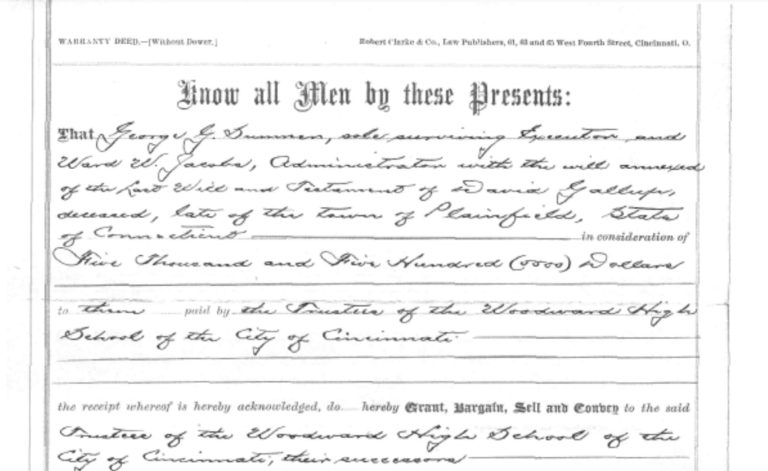
On 3/1/1886, the executor of the estate of David Gallup sold a parcel of land (now 1432 Main Street) to Woodward Trust for $5,500.
In 1895, the 1851 contract was modified to place all Cincinnati high schools under the exclusive authority of the Union Board, which would be supported by funds appropriated by the Board of Education (to which an annual accounting was required).
This amendment assigned permanent jurisdiction over all Cincinnati high schools to the Union Board, granted the Board of Education one more member (now 7) on the Union Board and assigned permanent supervision of the high schools the Superintendent of Schools.
In 1918, the third Woodward High School building replaced the second.
From 1851 through about 1935, the extent of control wavered between the Board of Education and the Union Board. As the years passed, however, the Board of Education progressively restricted the scope of the Union Board’s management until it was little more than an advisory body. The Woodward Trustees disputed this power shift and eventually, in retaliation, withheld income from its funds for several years.
By the early 1940s, Woodward High School had more inadequate facilities than any other Cincinnati high school, missing even a playfield for its students (even more necessary due to the extremely congested location and its serving the more underprivileged classes coming to it from the “basin of the city.”). This was interpreted by many as an indication of how far astray the Woodward Trustees had gone from the clearly defined purposes expressed in William Woodward’s deeds.
In 1945, as a result of these and other factors, a group of individuals lead by J.R. Allias brought suit against George Dornette and the other Woodward Trustees. (See separate summary of that case.) In this action, the court ultimately nullified the most significant arrangements and actions of the Woodward Trust of the previous 100 years – most notably in this context, that the Woodward Trust could not give its income into a general public fund nor provide, without compensation, the building and land for a public high school.
Research Still in Progress
We have, as yet, been unable to completely determine what occurred as a result of the court’s rulings in the Dornette v. Allais case. It is known that Woodward Trust ceased giving its income into the general public school fund, and thereafter created what we now know as the Student Assistance Fund, administered through the Board of Education, to assist financially poor children. Based on current land records, it would appear that the Board of Education purchased (for an unknown amount on an unknown date) the land underlying Woodward High School (Lots 60 & 61).
There are several other anomalies arising from comparison of an 1860 Plat of properties owned by Woodward Trust and current land records:
Public Parks:
[Hamilton County Parcels 075-0004-0026 thru 0029]
[Hamilton County Parcels 075-0001-0017 & 0018; 075-0001-0021 thru 0023]
[Hamilton County Parcels 075-0004-0051 thru 0053]
Land records indicate the purchase of these lots by different individuals from 1938-1965. After some additional transfers, the City of Cincinnati purchased the lots in 1975 and is currently shown as the owner.
Donations
What will your legacy be?
Embodying the enduring vision of the Woodwards, both Woodward High School and Woodward Trust stand as living testaments to their commitment. Throughout the years, numerous others have joined this legacy, contributing funds and assets that reflect their unique perspectives, thereby enriching the lives of Cincinnati's students. Woodward Trust actively invites and embraces donations from individuals, foundations, corporations, and organizations keen on supporting educational opportunities for Cincinnati's students. Join us in shaping the future of education for generations to come.

